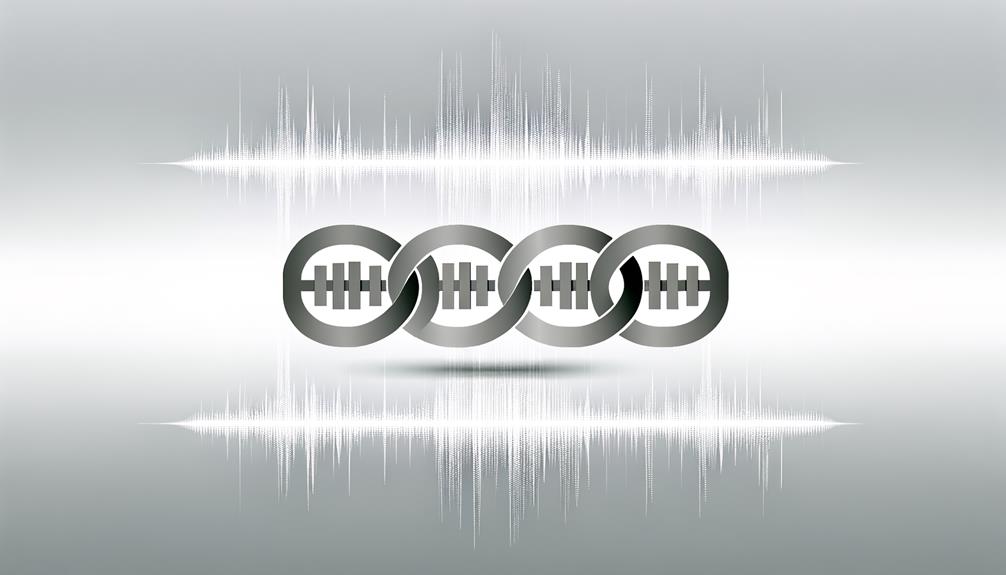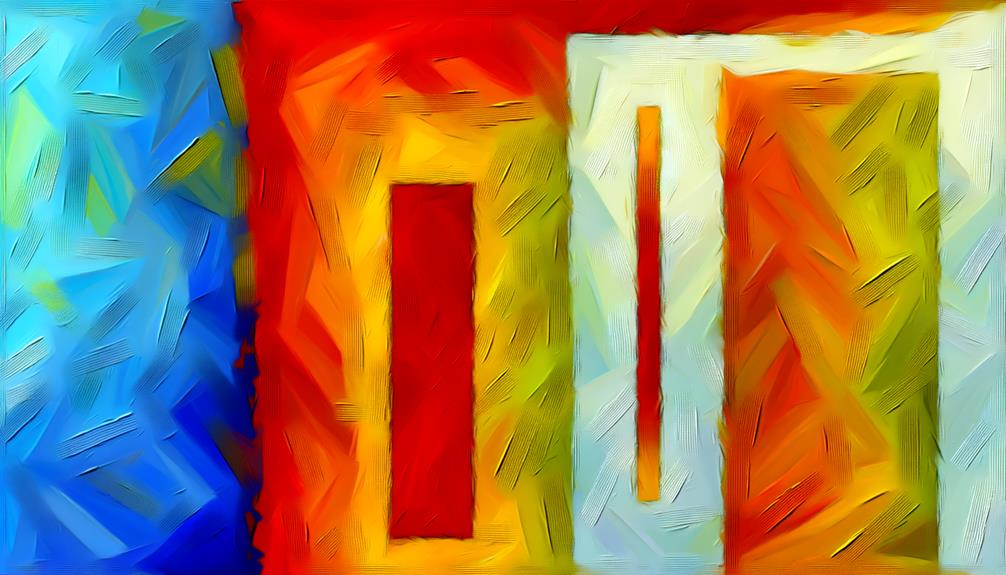What Is the Meaning of the Two Vertical Lines Symbol in Different Contexts?
The symbol of two vertical lines, '||', holds significant meaning across various fields. In mathematics, it denotes absolute value and parallelism.
Programmers use it as a logical OR operator, enhancing conditional statements. Linguistically, it aids in phonetic segmentation and syntax delineation.
Artists and designers leverage vertical lines for stability and structural integrity, symbolizing strength and growth. In Eastern philosophies, they represent balance and spiritual progression.
These interpretations paint a broad picture of its versatile use. Explore its deeper connections to see how this simple symbol integrates into different contexts and practices.

Key Takeaways
- In mathematics, two vertical lines denote absolute value.
- In Boolean algebra, two vertical lines represent the logical OR operator.
- In Unix-based systems, two vertical lines streamline command execution in shell scripting.
- Vertical lines in art symbolize strength and stability.
- In typography, vertical lines are used as delimiters for organizing data.
Historical Origins

The historical origins of vertical lines as symbols can be traced back to ancient civilizations where they were often utilized in art and writing to convey structure, order, and hierarchy. In ancient Egyptian hieroglyphs, vertical lines denoted concepts of stability and permanence, often appearing in depictions of architectural elements like columns.
Similarly, in ancient Chinese script, vertical strokes formed the backbone of characters, illustrating their fundamental importance in communication. Mesopotamian cuneiform scripts also employed vertical lines to demarcate sections of text, ensuring clarity and organization.
These early uses underscore the inherent human inclination to use simple, linear forms to represent complex ideas and social structures, reflecting a universal desire for order and meaning in visual language.
Mathematical Significance
Building on their historical significance, vertical lines have also maintained a profound role in the field of mathematics, where they are utilized to denote absolute value, partition number lines, and define geometric constructs such as slopes and vectors.
Their mathematical significance can be summarized as follows:
- Absolute Value: Vertical lines are placed on either side of a number or expression (e.g., |x|) to represent its absolute value, indicating its distance from zero on the number line, regardless of direction.
- Partitioning Number Lines: Vertical lines are used to partition number lines into segments, particularly in graphing inequalities and defining intervals.
- Geometric Constructs: In geometry, vertical lines help define slopes, vectors, and other critical elements, making them indispensable in spatial reasoning and vector calculus.
These applications underscore their indispensable role across various mathematical disciplines.
Programming Usage

In the world of programming, vertical lines, often referred to as pipes, serve critical functions such as representing the logical OR operator in many languages, streamlining command execution in shell scripting, and enhancing conditional statements' flexibility. For instance, in languages like C++ and JavaScript, the double vertical line (||) is used to evaluate multiple conditions efficiently. Similarly, in Unix-based systems, the single vertical line (|) facilitates inter-process communication by allowing the output of one command to become the input of another, thereby optimizing script functionality.
Logical OR Operator
A fundamental element in programming, the logical OR operator (often represented by vertical lines or '||'), plays an important role in decision-making processes within code structures. This operator evaluates multiple conditions and returns true if at least one of the conditions is met, thereby facilitating complex logical comparisons and flow control.
Here are three key aspects to understand:
- Conditional Logic: The logical OR operator is pivotal in if-else statements, allowing for flexible and adaptive decision-making.
- Boolean Expressions: It is used to combine multiple boolean expressions, enhancing code efficiency and readability.
- Error Handling: In some scenarios, the logical OR operator helps in providing fallback options, ensuring robust error handling and code stability.
Understanding the logical OR operator is essential for writing effective and efficient code.
Pipe in Shell
When working within Unix-like operating systems, the pipe symbol '|') is an essential tool that allows the output of one command to be seamlessly directed as input to another, thereby enabling powerful and efficient data manipulation workflows. This method of chaining commands can streamline complex tasks. For example, one might use `ps aux | grep apache` to filter running processes to find only those related to Apache. The versatility of pipes extends to various utilities like `awk`, `sed`, and `sort`, facilitating dynamic data processing without the need for intermediate files. This capability not only enhances productivity but also guarantees that scripts remain concise and maintainable. Mastering the use of pipes is vital for any serious shell programmer.
Conditional Statements Application
Building on the ability to manipulate data streams using pipes, the judicious application of conditional statements in programming enables developers to create more adaptable and intelligent scripts. Conditional statements allow programs to execute different actions based on varying inputs and conditions, enhancing decision-making capabilities. The two vertical lines symbol (`||`) is commonly utilized in many programming languages to denote logical OR operations, contributing to robust conditional logic.
Consider these applications:
- Error Handling: Use `||` to execute an alternative command if the preceding one fails.
- Flow Control: Implement conditional branches to direct program flow based on variable states.
- Optimizing Performance: Skip unnecessary operations by evaluating conditions early.
This nuanced use of conditional statements fosters more efficient and responsive code.
Symbol in Logic
In the domain of logic, vertical lines, often represented as '|', serve as critical symbols for denoting various logical operations and relations, such as absolute value, conditional probability, and divisibility.
In mathematical logic, the symbol '||' signifies the logical OR operation, a fundamental component in Boolean algebra. Moreover, within set theory, '|' can indicate membership conditions, enhancing the clarity of complex logical statements.
In number theory, '|' is utilized to express divisibility, as in 'a | b' meaning 'a divides b.' Additionally, in conditional probability, the vertical bar separates the condition from the event, as in P(A|B), denoting the probability of A given B. These uses underscore the vertical line's versatility in facilitating precise logical expressions.
Linguistic Applications

Vertical lines play a significant role in linguistic applications, particularly in the fields of phonetics and syntax, where they are employed to demarcate segments, hierarchies, or prosodic boundaries in a structured and precise manner. This utility enhances the clarity and accuracy of linguistic analysis, benefiting both research and pedagogy.
Here are three key applications:
- Phonetic Transcription:
Vertical lines are used to separate different phonetic elements, aiding in the detailed representation of speech sounds.
- Syntactic Structures:
They help delineate syntactic hierarchies, making complex sentence structures more comprehensible.
- Prosody Marking:
Vertical lines indicate prosodic boundaries, such as intonation phrases, facilitating the study of speech patterns and rhythms.
These uses underscore the importance of vertical lines in linguistic precision and clarity.
Cultural Interpretations
Cultural interpretations of vertical lines span a diverse array of contexts. In Eastern philosophical symbolism, they often represent the connection between the earthly and the divine. In modern design contexts, vertical lines signify strength, stability, and progress.
These interpretations reflect historical and spiritual connotations and also influence contemporary aesthetics and functional design principles. By examining these cultural perspectives, we can gain a richer understanding of the multifaceted meanings attributed to vertical lines.
Eastern Philosophical Symbolism
Exploring the rich tapestry of Eastern philosophical symbolism, vertical lines often represent the connection between the earthly and the divine, reflecting a deeper metaphysical understanding rooted in ancient traditions.
This duality is a prominent theme in various Eastern philosophies, illustrating a balance between material existence and spiritual ascension.
Key interpretations include:
- In Taoism: Vertical lines symbolize the balance between Yin and Yang, the fundamental forces that shape the universe.
- In Hinduism: They are seen as a representation of the spiritual journey from the mortal world to higher planes of consciousness.
- In Buddhism: Vertical lines signify the path to enlightenment, connecting the mundane with the transcendent.
These interpretations highlight the profound significance of vertical lines in Eastern thought, emphasizing harmony and spiritual progression.
Modern Design Contexts
Frequently, modern design contexts imbue vertical lines with meanings that reflect both contemporary aesthetic values and nuanced cultural interpretations. In graphic design, two vertical lines often symbolize balance, stability, and progress, mirroring the duality seen in many cultural contexts. In architecture, these lines can denote strength and continuity, resonating with the structural integrity of buildings. In fashion, vertical lines elongate form, suggesting elegance and sophistication. Below is a table summarizing these interpretations:
| Context | Symbolic Meaning | Cultural Interpretation |
|---|---|---|
| Graphic Design | Balance, Stability | Duality, Equilibrium |
| Architecture | Strength, Continuity | Structural Integrity |
| Fashion | Elongation, Elegance | Sophistication, Grace |
| Digital Media | Connectivity, Structure | Modernity, Interconnection |
| Urban Planning | Order, Direction | Progress, Organization |
These multifaceted meanings illustrate the versatility and depth of vertical lines in contemporary design.
Symbol in Art

In art, vertical lines often serve as powerful symbols, representing strength, stability, and a connection between the heavens and the earth. These lines can evoke a sense of grandeur and permanence, frequently used to convey significant themes and emotions.
Spirituality: In religious art, vertical lines can symbolize the divine connection, as seen in the architecture of cathedrals with towering spires.
Human Form: Artists use vertical lines to represent the human figure, emphasizing upright posture and dignity.
Nature: Depictions of trees or tall landscapes often incorporate vertical lines to signify growth and resilience.
Modern Communication
Vertical lines play an essential role in modern communication, subtly influencing the design and layout of digital interfaces to convey clarity, order, and emphasis.
In user interface (UI) and user experience (UX) design, vertical lines often delineate sections, separating content into digestible parts. This visual segmentation aids in guiding the viewer's eye, enhancing readability and user engagement.
Vertical lines are also used in text formatting, such as the pipe symbol (|), to denote logical separation or to create lists within code and digital documents. They also appear in modern typography and branding, providing a sleek, sophisticated aesthetic that resonates with contemporary audiences.
In this way, vertical lines serve as subtle yet powerful tools to organize information and enhance the user experience in digital communication.
Common Misconceptions

A common misconception about vertical lines is that they are merely decorative elements rather than functional components in design and communication. This misunderstanding often undermines their true significance.
Vertical lines, particularly two vertical lines, serve pivotal roles in various contexts:
- Mathematics and Logic: They symbolize 'absolute value' or 'parallelism,' indicating specific mathematical relationships and calculations.
- Typography and Text Formatting: They act as delimiters in coding and text editing, essential for organizing data and enhancing readability.
- Design and Architecture: Vertical lines guide visual flow and structural integrity, influencing how space and form are perceived.
Understanding these applications highlights the practical importance of vertical lines beyond mere aesthetics. By recognizing their functional value, one can gain deeper insights into effective design and communication strategies.
Conclusion
The two vertical lines symbol, akin to a multifaceted gem, serves diverse purposes across disciplines such as mathematics, programming, logic, linguistics, art, and modern communication.
Its historical origins and varied applications underscore its significance and versatility.
While often misunderstood, the symbol's contextual usage reveals a tapestry of meaning that transcends mere typographical marks, embodying complex concepts and bridging various fields of human knowledge and culture.





